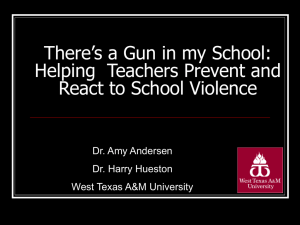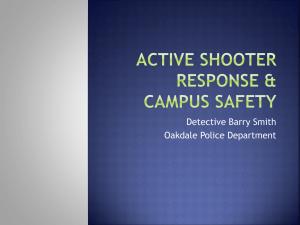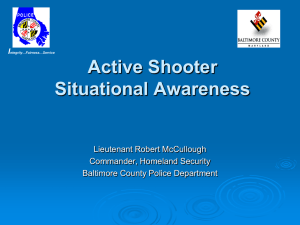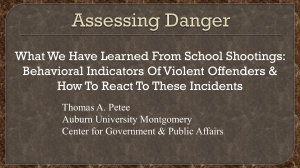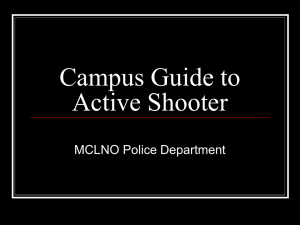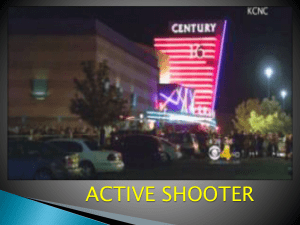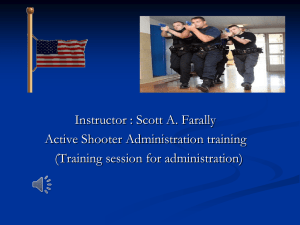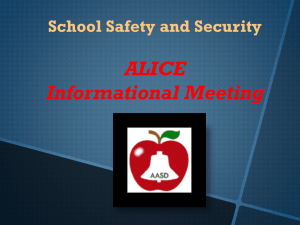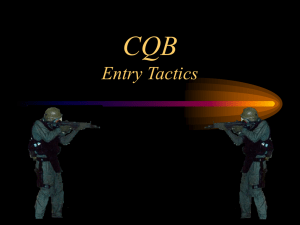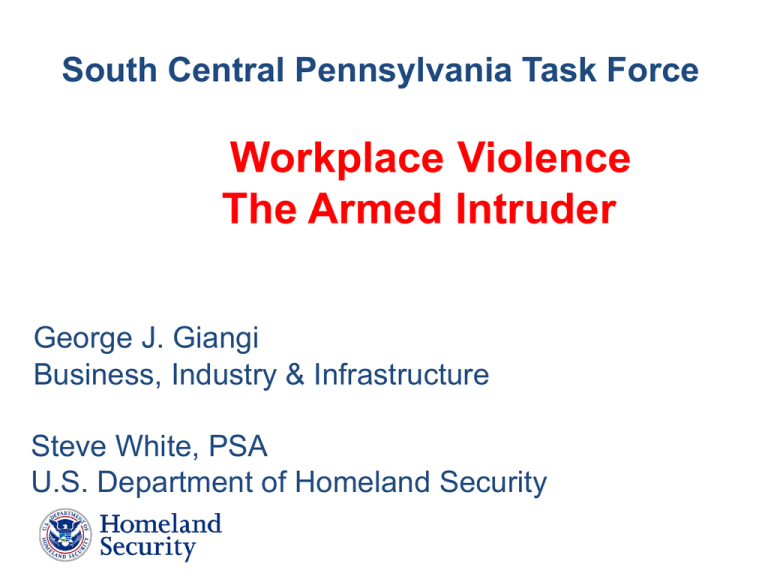
South Central Pennsylvania Task Force
Workplace Violence
The Armed Intruder
George J. Giangi
Business, Industry & Infrastructure
Steve White, PSA
U.S. Department of Homeland Security
1
Agenda
Active Shooter “How to Respond”
Police Response to Active Shooters
Facility Lockdown
Warning Indicators of an Active Shooter - Workplace Violence
2
Active Shooter – How To Respond
Training and Outreach
Materials consist of 3 products:
– Basic Guide Book
– Break Room Poster
– Pocket Emergency
Measures Guide
To download these
materials visit
www.dhs.gov/cfsector
5
Online Training
The Department of Homeland
Security (DHS) has released Active
Shooter, What You Can Do (IS-907),
a new online training course
available through the Federal
Emergency Management Agency
(FEMA) Emergency Management
Institute (EMI) at
http://training.fema.gov/EMIWeb/IS/I
S907.asp
The course is self-paced and takes
about 45 minutes to complete
6
Profile of an Active Shooter
An active shooter is an individual actively engaged in killing or
attempting to kill people in a confined and populated area
Active shooters typically use firearms and select their victims at
random
Active shooter situations may or may not be predictable and evolve
quickly but behavior precursors may be a sign
Typically, the immediate deployment of law enforcement is required to
end the shooting and mitigate harm to victims
Because active shooter situations are often over within ten to fifteen
minutes, before law enforcement arrives on the scene, individuals must
be prepared both mentally and physically to deal with an active shooter
situation
7
What is an Active Shooter? (cont.)
There is no definitive active shooter profile
– There have been no scientific studies of workplace shooters or
homicide perpetrators
– U.S. Secret Service studies of school shooters and presidential
assassins have resulted in no definitive active shooter profile
Profiling creates a high rate of false positives (believing someone
could be an active shooter) and false negatives (missing someone
who could potentially be an active shooter)
8
Characteristics of an Active Shooter Event
Attack is usually well thought through and planned in advance; however,
targets often are randomly selected
Almost every attacker studied has engaged in behavior prior to shooting that
seriously concerned others
In school settings, students often knew the shooting was to occur but did not
alert an adult
Often in a school or the workplace, clear warning signs are evident, such as
the showing or talking about weapon(s) ownership
In many cases, warning signs are ignored, downplayed, or misjudged
9
Agenda
Active Shooter “How to Respond”
Police Response to Active Shooters
Facility Lockdown
Workplace Violence Awareness
10
Active Shooter Vs Barricaded Gunman
Active Shooter- A situation where one or more
people are in the process of causing death or
injury or posing an immediate danger thereof.
11
Active Shooter Vs Barricaded Subject
Barricaded Subject- Any individual who is
reasonably believed to be a threat to commit
serious bodily injury or death to hostages,
officers, or others in the community and who is in
a stronghold or contained position.
12
Police Response to Active Shooter
Police must act now to save lives.
They will enter building/area with minimally safe
team.
They will move quickly to sounds/source of
violence.
They will move past victims.
They will engage and neutralize shooters.
13
Police Response to Active Shooters
CHAOS WILL INTIALLY REIGN
DURING ACTIVE SHOOTER
INCIDENTS.
14
Police Response to Active Shooters
15
First Priority of Responding Officers
The Neutralization (Kill or Capture) of the Active
Shooter. The speed that this happens will directly
effect the amount of lives saved.
The Officers responding will move with a
determined purpose, bypassing injured victims
until the threat is ended.
16
Other Priorities
Lives of those injured
Making sure area is safe (No Other Suspects)
Lives of those persons in the proximity to the
incident
Containment, Control & Accountability of
Shooting Scene
17
Police Response to Active Shooters
Responding Officers may grab fleeing civilians to
gather intelligence. (Where, How Many, Race,
Weapons, Sex, Clothing)
Officers will bypass IEDs to get to threat.
If Shooter is contained & life is not in imminent
danger return to SWAT tactics.
18
Uniforms
Responding officers will be from all sections of
the Police Departments. (Detectives, Patrol &
Command Staff)
Officers from neighboring departments will also
respond.
Be aware of Officers wearing different uniforms,
plain clothes or combination of both.
19
Weapons
Patrol Rifles
Shotguns
Sub Machine guns
Handguns
20
Equipment
21
Training & Developing Procedures
Police and Businesses must foster good working
relationships.
They must jointly develop procedures to deal with
Active Shooters.
They must train together to test these
procedures.
The training must be as real as possible.
22
Armed Presence
There have been multiple active shooter
incidents per year. In most of these incidents all
killing was done before first officer arrived on
scene.
An Armed Police/Security presence in your
facility is a strong deterrence against attack.
23
Communication with Law Enforcement
24
Agenda
Active Shooter “How to Respond”
Police Response to Active Shooters
Facility Lockdown
Workplace Violence Awareness
25
HR & Safety Department Responsibility
Human Resources Department:
– Conduct effective employee screening and background checks
– Create a system for reporting signs of potentially violent behavior
– Ensure employee termination procedure assesses the potential for
workplace violence & considers protective measures
Facility / Safety / Security Department:
– Institute access controls (i.e., keys, security system pass codes)
– Physical security of the location
– Provide an emergency notification system for facility
– Develop Facility Lockdown Plan
– Test Plan
– Train employees on plan and workplace violence awareness
26
Facility Lockdown
• Do you have a Facility Lockdown procedure?
• Have personnel been briefed on it?
• Have you coordinated the plan with police and colocated facilities?
• It does not have to be very complicated or very lengthy
27
Sample Lockdown Procedure
• Make an announcement over the public address system
to implement a Facility Lockdown
• Immediately lock all interior doors
• Area supervisors are to immediately direct all personnel
(employees, customers, visitors, vendors…) in their area
to evacuate the facility if it can be done safely.
• If evacuation can not be done go to the nearest room.
Lock the door, turn off lights, close all blinds and shades
on exterior windows and remain out of sight in the part of
the room so that you cannot be seen.
28
Sample Lockdown Procedure (con’t)
Place cell phones and pagers in silent mode.
Turn off noisy equipment such as copiers, fax machines
Keep personnel as calm as possible and try to notify 911 (using
cell phones or telephones) of your location, number of
occupants and status.
Remain in the room until an all-clear signal is given or law
enforcement arrives.
Prepare an incident report documenting personnel observations
29
Post Incident Management
– Accountability of all individuals at a designated
assembly point to determine missing and injured
– Notification of families of individuals affected by the
active shooter, including notification of any casualties
– Assessment of the psychological state of individuals at
the scene, and provide counseling services
– Identification of any critical personnel or operational
gaps left in the organization as a result of the active
shooter
30
Agenda
Active Shooter “How to Respond”
Police Response to Active Shooters
Facility Lockdown
Workplace Violence Awareness
31
Situational Awareness
Are there any especially inflammatory events that are ongoing in
your facility?
Personnel layoffs?
Gang activity?
Economic hard times?
Rash of bomb threats?
Feeling that they are not being treated fairly?
Strong anti-government sentiment?
32
Recognizing Potential Workplace Violence
An active shooter in your workplace may be a current or former employee, or
an acquaintance of a current or former employee or customer
Intuitive managers and coworkers may notice characteristics of potentially
violent behavior in an employee
Alert your Human Resources Department if you believe an employee or
coworker exhibits potentially violent behavior to include:
– Increased use of alcohol and/or illegal drugs
– Unexplained increase in absenteeism; vague physical complaints
– Noticeable decrease in attention to appearance and hygiene
– Depression/withdrawal
– Resistance and overreaction to changes in policy and procedures
– Repeated violations of company policies
– Increased, severe mood swings
33
Behaviors of Concern
The following may alert supervisors to potential problems
✦Threats, frequent aggressive outbursts, or excessive
displays of temper, strong anti-social behavior
✦History of threats/violent acts
✦Obsession with weapons and/or references to weapons,
violent media content, or violent events
34
Behaviors of Concern
✦Verbal abuse of co-workers and customers, or
harassment through phone calls or emails
✦Bizarre comments or behavior, including violent content
✦Holding grudges, inability to handle criticism, making
excuses, and blaming others
✦Chronic, hypersensitive complaints about persecution
✦Making jokes or offensive comments about violent acts
35
Online Training
The Department of Homeland
Security (DHS) has released IS906 Workplace Security
Awareness, a new online training
course available through the
Federal Emergency Management
Agency (FEMA) Emergency
Management Institute (EMI) at
http://training.fema.gov/EMIWeb/IS
/IS906.asp
The course is self-paced and takes
about 45 minutes to complete
36
For more information, visit:
www.dhs.gov/cfsector
Or email the Commercial Facilities Sector-Specific
Agency
cfsteam@hq.dhs.gov
Questions
George Giangi
South Central PA Task
Force
giangiw@aol.com
717-312-1127
38

